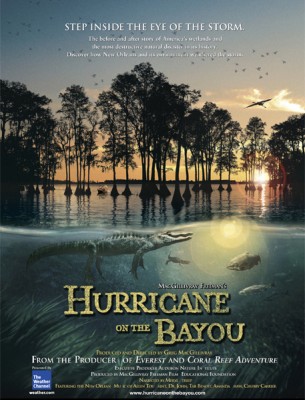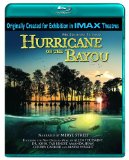| Reviews & Columns |
|
Reviews DVD TV on DVD Blu-ray 4K UHD International DVDs In Theaters Reviews by Studio Video Games Features Collector Series DVDs Easter Egg Database Interviews DVD Talk Radio Feature Articles Columns Anime Talk DVD Savant Horror DVDs The M.O.D. Squad Art House HD Talk Silent DVD
|
DVD Talk Forum |
|
|
| Resources |
|
DVD Price Search Customer Service #'s RCE Info Links |
|
Columns
|
|
|
Hurricane on the Bayou
IMAX films have been released to DVD for quite a while but Blu-ray inches it one big step closer toward an approximation of the original theatrical experience. The disc is above average compared with other nature/science/travelogue titles released so far in HD DVD and Blu-ray. On a big monitor or projected on a screen, it's an impressive-looking show with terrific sound, and there's lots of additional clips in high-def from other films produced by the same company.
Hurricane on the Bayou went into production in 2005 as a simple documentary about the vanishing wetlands adjacent to New Orleans, and how the building of levees, access canals, and global warming all have contributed to their decline. Directors Greg MacGillivray (also the producer) and Glen Pitre (also the screenwriter) were planning on recreating, presumably via CGI animation, which the finished film also incorporates, a Category Five Hurricane to show how the decline of the wetlands - an important buffer to major storms - could potentially devastate a major city like New Orleans. And then Hurricane Katrina came along.
To their credit, the filmmakers stuck to their guns and didn't shift the focus of their film to the devastation, tempting though that might have been. (I wish they could have made two films.) The resultant work is still chiefly a show about the impact on the wetlands rather than about Katrina's impact on New Orleans, and the hurricane doesn't even put in an appearance until the film is about half-over.
Nevertheless, it's the lingering aerial shots of the decimated city that have the biggest impact (my wife unexpectedly teared-up as soon as this footage began). The reason for this is that the gargantuan IMAX format matches the scope of the disaster: in these aerial shots, one can see with crystal clarity perhaps a hundred square miles where everything - whole neighborhoods - is underwater. Houses burn out-of-control because there's no way for firemen to reach them; in one incredible shot big freighters and tiny shrimp boats list on the dry pavement of a freeway bridge approach.
Like other IMAX films, Hurricane on the Bayou is resolutely apolitical. About the efforts to rescue those trapped by the storm, the narration reports only that help arrived "bit-by-bit, too late for some." That almost grotesque understatement is about as political as Hurricane on the Bayou gets, although the old adage that pictures speak louder than words applies here.
On the plus side, the film gets its environmental message across plainly and in terms very easy to understand, somewhat like An Inconvenient Truth. One very dramatic image shows what the wetlands looked like from space in 1930 vs. 2000. Wetlands covering more acreage than the entire State of Delaware were washed away in just 70 years.
At the heart of the film is teen prodigy Amanda Shaw, a talented Cajun violinist, whose family and colleagues are among those directly and devastatingly impacted by Hurricane Katrina. The personal touch and efforts to tell something like a narrative story in these IMAX shows often doesn't work, but in this case it boils down that great tragedy to an intimate level, and Shaw is enormously appealing, with real star power.
The film is narrated by Meryl Streep, but she's obviously there for marquee value; the narration is infrequent and minimal. If she spent more than an hour in the recording booth, somebody screwed up.
The film follows the usual format of these shows, at times catering to the audience-participation aspects of the IMAX format. There are the inevitable aerial shots where the horizon tilts back and forth, which in theaters gives the effect that the entire auditorium is tilting on a massive gimble. A subplot about a family of alligators and a brief visit to a Penguin house seem to have been a concession to the format; IMAX movies always seem to find room for animals and/or underwater footage, and this has both. There's some CGI recreations of Katrina that seem unnecessary, and with shows like this it's frustrating recreated footage isn't identified as such.
Video & Audio
Hurricane on the Bayou was filmed in IMAX, a format that uses 65mm film run horizontally through cameras (a la VistaVision) during production, and 70mm film horizontally through special projectors for theatrical exhibitions, and the huge frame size is the reason for the extreme clarity of the image. I'm not aware if the original film negative was used for this transfer, or whether some reduction element might have been sourced, but in any case the image is impressively sharp. All of the underwater footage and aerial shots look especially good. Like Cinerama, IMAX has its own visual language insofar as the format prefers slow tracking shots (with steady, deliberate motion in front of the camera), long takes, and the use of multi-screen imagery that will suffer on smaller monitors. The presentation is 1080p in 1.78:1 format; IMAX has a somewhat awkward theatrical aspect ratio of 1.44:1, and one or two shots appear tightly cropped, but otherwise it looks just great.
The audio is likewise impressive, DTS-HD Master Audio 5.1 (with an alternate French Dolby Digital 5.1 track but no subtitle options) with lots of directionality and oomph in New Orleans jazz/Cajun/zydeco-heavy soundtrack, including music by Dr. John, Allen Toussaint, Chubby Checker and others. The disc is region-encoded A / B / C; in other words, effectively region-free.
Extra Features
By far the best supplements are two in high-def: The History of MacGillivray-Freeman Films, running 7 1/2 minutes, and a collection of 12 IMAX trailers from the same company. Both of these extras are in high-def, covering a wide range of topics (flight, underwater footage, the Alps, the Grand Canyon, etc.) and there's one spectacular image after another. Also included is a pretty good "Making of" Documentary, of interest mainly for its technical aspects. There's an okay Movie Trivia Quiz, and text pages on the filmmakers, the musicians, and even the alligators. The disc is BD-Live Ready.
Parting Thoughts
I passed on getting IMAX shows on DVD, good as DVD is, because it just couldn't approach the visual splendor of IMAX presentations. But on Blu-ray films like Hurricane on the Bayou come reasonably close; one certainly can enjoy far more detail than ever before on a home theater system, making this Highly Recommended.
Film historian Stuart Galbraith IV's latest book, The Toho Studios Story, is on sale now.
|
| Popular Reviews |
| Sponsored Links |
|
|
| Sponsored Links |
|
|
| Release List | Reviews | Shop | Newsletter | Forum | DVD Giveaways | Blu-Ray | Advertise |
|
Copyright 2024 DVDTalk.com All Rights Reserved. Legal Info, Privacy Policy, Terms of Use,
Manage Preferences,
Your Privacy Choices | |||||||














